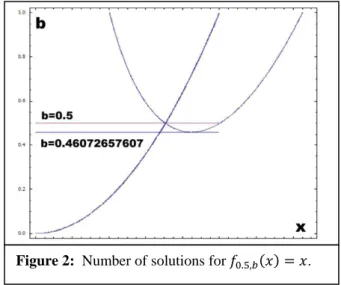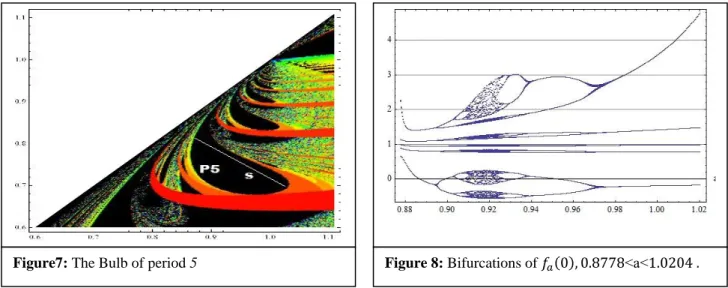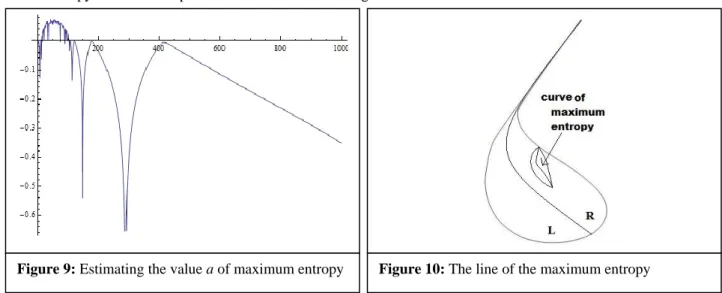Asian Online Journals (www.ajouronline.com) 209
Harvesting Dynamic Aspects from a Real Rational Map: The Bulb of
Period 5
João Cabral
Research Centre in Mathematics and Applications of the University of Évora, Portugal and Department of Mathematics of University of Azores, Portugal
Email: jcabral {at} uac.pt
_________________________________________________________________________________
ABSTRACT— This work is a small, but strong, contribute to understand better the behavior, under iteration, of the
Real Rational Map, f(x)=(x²-a)/(x²-b), with 0<b<a<1, with a and b real parameters. So, we show in this work how to choose some suitable regions of the parameter space (a,b), that allows a controlled and efficient study of this kind of maps, using some classical dynamical systems tools as the critical point orbit, Lyapunov exponents and their relation with the bifurcation diagram of the map.
Keywords— Dynamics, Real Rational Maps, Stability, Fixed Points, Bifurcation Theory
_________________________________________________________________________________
1.
INTRODUCTIONLet , a rational map with a and b real parameters, 0<b<a<1, with domain , and (a, b) a parameter space. These maps are a family with negative Schwarzian derivative, so its study is a contribution to extend the theories of Iterated Maps of the Interval, by Milnor and Thurston, in [6] and Hiperbolicity and Symbolic Systems, by Ramos, in [7].
In this work we choose the family with parameters, 0<b<a<1, because in this region we have one, two or three real solution for . We can obtain large real intervals, for a and b, with one or three solutions, but only one point , where this has two real solutions, see figure 1a, figure 1b and figure 1c.
Figure 1a: , for b<a<1 has one solution
Figure 1b: , for b<a<1 has two solutions
Figure 1c: , for b<a<1 has three solutions
Graphically, when we put the parameter b approaching the parameter a, we can see that the line y=x will approach the branch of the function for values , becoming tangent in one point, for some , and crossing it after this point.
For the values 0<b<a, but a>1 and b>1, when we do also we will assist the same phenomena but in this case the line y=x will approach the inner parabola of the function, for the values , touching it in one point also, and finally crossing it.
As an example, when we draw, implicitly, the solutions to , we obtain Figure 2, for a family a=0.5, with
b<0.5. It is easy to see that we will have only two solutions for the value , and three solutions for the
values .
Following the usual notation, used in the study of dynamical systems, see [4], in this paper we will use the symbol to denote the function composition ( , n times. For a point , we define the orbit of x, under
f, as . Each element of this set is the result of one composition of order n of the
3 2 1 1 2 3 4 2 2 4 6 3 2 1 1 2 3 4 2 2 4 3 2 1 1 2 3 4 2 2 4
Asian Online Journals (www.ajouronline.com) 210
map f. Each step of the composition is also known as iteration, when we repeat the same map in the composition.
In general all the terms that we will use can be found very easily in all references of this paper. So, our goal in this paper is to show how we can build a parameter space (a,b) and find some regions, where the map is easy to control under iteration. With this control we can harvest some nice properties of this family of maps and apply the most common tools used to study the behavior of the quadratic map, or the tent map, see [4], [6] and [7], on the dynamics study field.
In our map the recognition of the interval, or value, of b, where we can have one, two or three fix points, initially, is important since this after iteration the map will behave differently. If the map has one fixed point initially, after iteration we will have 1, 3, 7, 15, …, fixed points. If the map has three fixed points initially, after iteration we will have 3, 5, 9, … fixed points.
2.
THE PARAMETER SPACE(a,b)
Solving the generic equation , with 0<a<3 and 0<b<2, for n=1,2,3, …, using the Parametric Plot of a program like Wolfram Mathematica, we obtain as result the black regions of the figure 3, where we can find at least one solution to it.
But, for us, it only matters the regions that are present in 0<b<a<1, because these are the solutions that corresponds to our specific family. So we will choose it to work, and with some magnification we obtain figure 4.
As we can see in figure 4, exists some regularity connected to the black regions, that resembles the existent similarity of the Mandelbrot set for complex quadratic rational maps, see [4].
Definition 2.1: We define Bulb of period n, the region of the parameter space (a,b) of , where we can find solutions to the equation , for some fixed n=1,2,3,….
Figure 2: Number of solutions for .
Asian Online Journals (www.ajouronline.com) 211
One of the main characteristics of a Bulb of period n is that the parametric line, solution of the equation , crosses the Bulb dividing it in two regions, that we will call L and R, as we see in figure 5. This happens in all other Bulbs, as we can see in figure 6, and it is easy to prove that the line can be found in all Bulbs, since they are the result of the equation and x=0 is a particular case of it.
3.
THE BULB OF PERIOD 5When we magnify the parameter space to values close to the neighborhood of a=b=1, we can see the self-similarity of the parameter space (a,b), as showed in figure 7. We will explore more closely the Bulb of period 5, and reduce our map of two parameters to only one, making , for a fixed real k and m<0. Doing that we will construct lines like the line s on the figure 7. Choosing values and , with , and for a specific k, we can build a segment of the line s that is merged in the interior of the Bulb of period 5. If we draw the bifurcation diagram, see [1] and [4], to obtain some explanation about this kind of graphic, for example, for , with a we have the figure 8. This values of a make us dealing with a line segment in the interior of the Bulb of period 5.
We can observe that the orbit of x=0, one of the critical points of our map, appears from a border collision bifurcation, then goes stable until the doubling period bifurcation starts. So we can see orbits of period 5, 10, 20,… and then chaos emerge as the quadratic map. Then the orbit of zero returns from chaos and orbits 5.n, with n=1,2,3,4,… can be found. At some point the topological entropy, see [5], will reach its maximum, it is somewhere on the neighborhood of the value
a=0.92. This point is important since it is the point when the reverse order of bifurcation occurs, creating this phenomena
that we know as reverse bifurcation.
Figure 5: The Bulb of period n.
0 0.2 0.4 0.6 0.8 1 -0.5 -0.25 0 0.25 0.5 0.75 1
Figure 6: The Bulbs of period n=2,3,4,5,….
Asian Online Journals (www.ajouronline.com) 212
We can use Lyapunov exponents, see [5] and [7], to calculate this value, by approximation, where the map reaches its maximum entropy. See the example of one of these results in figure 9.
With some time and a lot of calculus, we can improve figure 5 to figure 10 and approximate with some precision, numerically, the curve where we can obtain the maximum entropy for the orbit of the critical point.
If we build limits to a in a way that allows us to build one region where the value of entropy will be different of zero, that is, , and for and the doubling period bifurcation starts for the orbit of the critical point, we can deduce that these regions are only on the interior of region R.
So, observing the results for the Bulb 5 we can see that the same happens to the other Bulbs in a direct manifestation of the self-similarity, and allow us to propose the following results, written in conjectures 1 and 2.
Conjecture 3.1: The orbit of the critical point in the region L of the Bulb of period n is stable for g(a)=m.a+k, to all
slopes m, positives or negative ones.
Conjecture 3.2: The orbit of the critical point in the region R of the Bulb of period n is stable for g(a)=m.a+k, to
slopes m>0, but for slopes m<0 exists unstable orbits.
Numerically we can see that both conjectures are true, but we didn’t find a suitable analytically proof for both results due to the nature of real rational maps iteration.
4. CONCLUSIONS
After all the observations that we made numerically, using the software Wolfram Mathematica, we can see that it is not easy to identify which area, or region, is dominate by the iteration of x=0 when we start with one fixed point, with two fixed points or three fixed points, since they appear in calculus all mingled together in one orbit. So, probably we will need to develop some new tools to dig deeper on the behavior of these classes of maps.
With the help of our parameter space (a,b) it is easy to an infinity number of regions, very well defined, where the real rational map has stable orbits for the critical value.
After a better and complete description of the region R of the Bulbs will be possible to verify, or at least, find some clues, about why the reverse bifurcations happens or if they exist in all family of maps.
Applying the work developed in [2] and [3] for this family of maps, exactly in these regions, it will be possible to describe symbolically the dynamic of these maps. We can work in regions of complete stability of the critical orbit, and in regions where it will occur period doubling bifurcations routing the research to the creation of a star product to calculate the entropy of higher orders, impossible to calculate with the computer.
5. REFERENCES
[1] Alsedà L., Llibre, J., Misiurewicz, M., “Combinatorial Dynamics and Entropy in Dimension One”, Second Edition, Advanced Series in Nonlinear Dynamics, vol.5, World Scientific, 2000.
[2] Cabral, J., “Hunting Admissible Kneading pairs of a real rational map”, Asian Journal of Fuzzy and Applied Mathematics, Vol. 1, number 4, December 2013.
[3] Cabral, J., “Symbolic Dynamics for Real Rational Maps”, Asian Journal of Fuzzy and Applied Mathematics, Vol.1, number 4, December 2013.
[4] Devaney, R., “An introduction to chaotic dynamical systems”, 2nd edition, Perseus Books, 1989.
[5] Katok, A., “Lyapunov exponents, entropy and periodic orbits for diffeomorphisms”. Publications Mathématiques de l’IHÉS, 51, p.137-173.
Asian Online Journals (www.ajouronline.com) 213
[6] Milnor J., Thurston W., “On iterated maps of the interval”, In Dynamical Systems proc. Univ. Maryland 1986-87, pp. 465-563, Lect. Notes in Math., Springer-Verlag, 1988.
[7] Sousa Ramos, J. “Hiperbolicidade e Bifurcação de Sistemas Simbólicos”, Phd Thesis, Technical University of Lisbon, available at http://purl.pt/7368, 1989.



